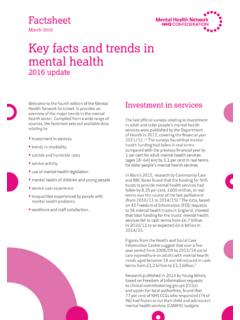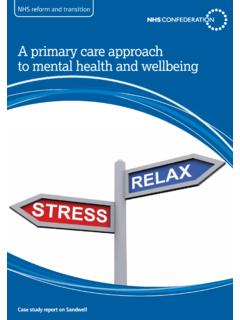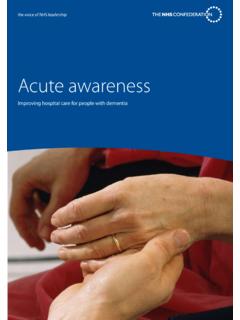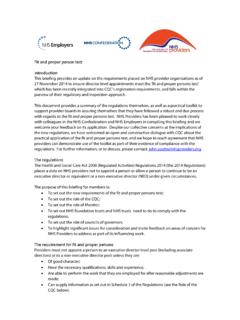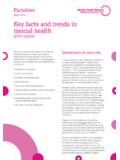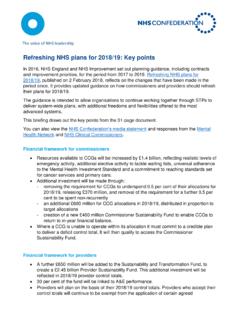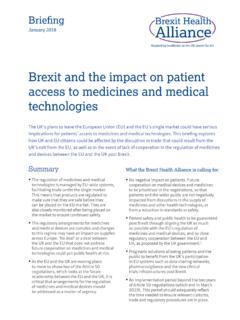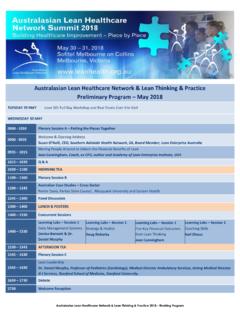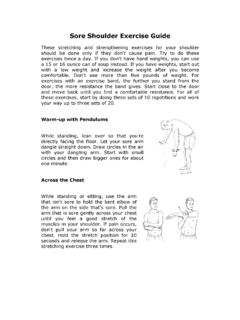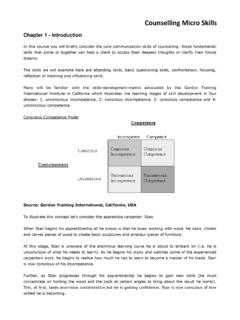Transcription of Lean thinking for the NHS
1 lean thinking for the NHSD aniel Jones and Alan Mitchell, lean Enterprise academy UKA report commissioned by the NHS ConfederationAn NHS Confederation leading edge reportThe NHS Confederation brings together theorganisations that make up the modern NHS acrossthe UK. We help our members deliver better healthand healthcare by: influencing policy and the wider public debate onthe full range of health and health service issues supporting health leaders through informationsharing and networking working for employers to improve the workinglives of staff and, through them, to provide bettercare for more information on our work, please contact:NHS Confederation29 Bressenden PlaceLondon SW1E 5 DDTel 020 7074 3200 Fax 020 7074 3201 Email views and opinions in this publication are thoseof the author and are not the authorised views oropinions of the NHS Confederation.
2 The NHSC onfederation shall not be liable for any indirect,special, consequential, or incidental damages ordefamation arising from any views, opinions orinformation contained within this Charity no. 1090329 Published by the NHS Confederation NHS Confederation 2006 ISBN 1 85947 127 7 Ref: BOK 56701 The voice of NHS leadershipAcknowledgementsThis report was written by:Daniel Jones and Alan Mitchell, lean Enterprise academy UKwithDavid Ben-Tovim, Flinders Medical Centre, AustraliaDavid Fillingham, Bolton Hospitals NHS Trust, UKCarol Makin, Wirral NHS Trust, UKKate Silvester, National Osprey Coach, UKDavid Brunt, lean Enterprise academy , UKIan Glenday, lean Enterprise academy , UKVersions of this report are available that providegreater accessibility for those with a visualimpairment.
3 For more information please contactour publications team on 0870 444 need for change3A good start4 The benefits of Lean6 Why lean works7 How lean works11 Core principles16 Getting started18 Involving staff21 The lean journey22 Conclusion23 Where to learn more24 AcknowledgementsContents We asked the lean Enterprise academy to look athow Toyota s approach to production could beapplied to healthcare. This is not as odd as it firstappears. The Toyota system often known as lean has been applied in many environments, includinghealthcare (and not just manufacturing) for sometime now, with staggering improvements in qualityand efficiency. The underpinning values of removingactivities that don t add value and of respect forpeople and society lie at the heart of the principles on which lean is based aregeneric.
4 They can be applied anywhere: at home, in a bank, GP practice or number of things have struck me about places I have visited where people are implementing , the clinicians are involved and seem to be having fun. Secondly, the scale ofthe improvements is often extraordinary. Moreproblematically, the transformations require wholeprocesses to be looked at, with teams sometimestaking an entire week out often more than once. It is also striking how far lean principles run counterto received common sense they challenge thewhole idea of economies of scale, of batching andqueueing work, triage and de-skilling. Many of theseideas about the organisation of work are deeply heldand often wrong.
5 Most counter-intuitive of all is theidea that we can get more done by working thesystem less hard. The results are potentially very significant. lean sfocus on delivering care is a refreshing antidote tobenchmarks, targets and the traditional approach to performance management. The emphasis it putson looking at the whole system is valuable. For me, one of the most important insights is that many traditional approaches to efficiencyimprovement are futile and focus on the wrong thing. In most organisations of whatever type, there is atleast nine times more non-value-adding activitythan there is work that actually meets the patients needs. So even if the value-adding component isimproved by 50 per cent this will have a very smallimpact on overall productivity.
6 Improving value-adding components in isolationwithout addressing the whole process may notimprove efficiency at all. A faster machine inpathology or a quicker transfer from accident andemergency to a ward may simply mean that thespecimen or the patient waits somewhere differentand longer for the next stage in the process. lean focuses the improvement effort on thingsthat matter to patients and clinicians, and on thethings that cause them stress and get in the wayof care as opposed to external benchmarks ornational targets, which tend to be expressed interms that are only indirectly related to improvingpatient care. There is one other key insight I have gained fromtalking to people developing lean approaches.
7 Leanhas to be locally led and be part of the organisation sstrategy. It cannot be imposed from outside: a sureway to kill it would be for there to be a national orregional lean Enterprise academy has set up a LeanHealthcare Network to help people exchange ideas and experience. The NHS Confederation s Future Healthcare Network is also investigating the very significant implications for the design and size of buildings. Details can be found at theend of this Edwards, Policy Director NHS ConfederationForeword2 lean thinking for the NHSA lthough the NHS has made significant progressover the last few years, there is a nagging doubt thatthe improvements should have been more , there are many significant challenges that stillneed to be addressed, including: financial deficits hospital-acquired infections and avoidable injuryand death capacity constraints accusations of endemic inefficiency public and political concern about waiting listsand problems like these are common to manyindustries.
8 Poor safety and quality, capacityconstraints and queues, cash-flowcrises, lowlevelsof efficiency and lowlevels of staff motivation arenot confined to the NHS. They plague organisationsacross the world, particularly in here is the good news. It is possible to improvequality (to deliver better and more timely patientcare), to make working lives less stressful and morerewarding for staff and to boost efficiency andproductivity (thereby pleasing politicians andtaxpayers), all at the same it s possible to do all these things withoutpainful restructurings, cash injections or massivenew investments in infrastructure or IT by applyingthe principles of lean to the health report introduces the concept of lean .
9 It showshow lean is already being applied in the healthsector, and why it is essential to a strong, successfulNHS. Its message is simple. lean can help save healthcareSceptical? So you should be. But please rememberthree things as you read enormous amount of work has already beendone in the NHS which has prepared the groundfor lean : work done to clear bottlenecks at everypoint in the patient s journey; to understand thescale and the causes of variability of demand andto smooth it where possible. lean builds on thislarge body of excellent work, adding some moretools and providing more of a framework. 2 Remember that lean is not a management fad. Itis a tried and tested methodology for improvingthe way work gets done.
10 lean has been spreadingslowly and inexorably from industry to industry forover half a century as its principles have been fine-tuned, tested, demonstrated and proved largelyagainst the better judgement of people wholooked at it and declared it will never work here! 3If your hospital is struggling with end-of-yearfinancial deficits, ward closures and redundancies, lean is not going to be your saviour in the shortterm. lean will make immediate improvementsand help you avoid deficits in the medium to long term, but it cannot help you resolveimmediate financial crises. Indeed, because Leanprinciples take time to embed, and because theirapplication relies on the positive commitment and support of staff in their day-to-day work, thebest way to squander the opportunity presentedby lean is to link it to short-term other words, lean is about building a positivefuture managing healthcare organisations in acompletely different way so that short-term fire-fighting becomes a thing of the past.
